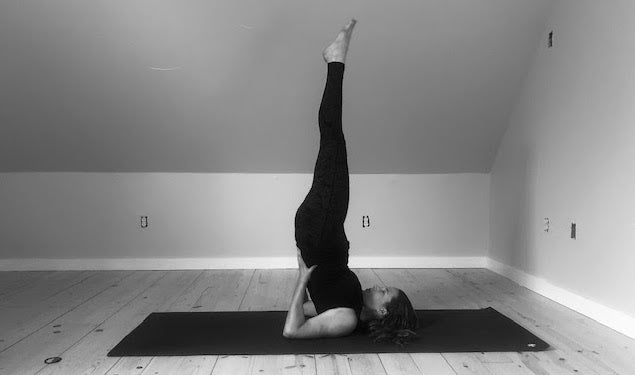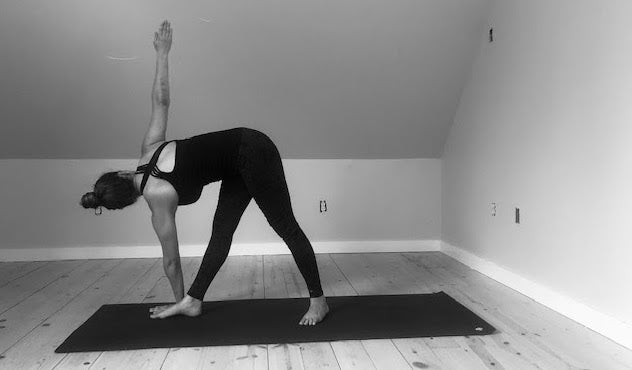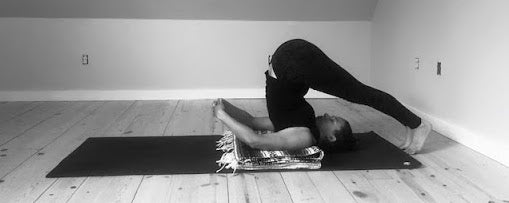
Salamba Sarvangasana: An Ayurvedic Guide to Shoulderstand

Salamba Sarvangasana, commonly known as Shoulderstand, is a wonderful, safe inversion that invites fresh prana into the body and brings a refreshed perspective into your day. Inversions in yoga are defined as postures where your head is below your heart. Many people think of headstand and handstand when they hear the word inversion; however, something as simple as Downward Facing Dog is an inversion and carries many of the same benefits of more advanced inversions. This all being said, Shoulderstand is a great posture to begin with if you are just starting out on your inversion journey.
Some of the many benefits of Shoulderstand include:
Let’s take a look at how Salamba Sarvangasana effects the three doshas:
Vata- Shoulderstand is extremely beneficial for calming and grounding vata dosha. This posture brings us out of our sympathetic nervous system, also known as the fight or flight response, and into our parasympathetic nervous system where we can restore the nervous system and fortify our bodies and minds. It also can help expel vata type gas and reduce vata type insomnia. When working to balance vata dosha in Shoulderstand, focus on holding still and stable and taking long smooth breaths in and out through the nose.
Pitta- Many inversions are not recommended for pitta dosha because they can bring excess heat into the mind and brain. Also, pitta types tend to overdo it and overexert themselves in general; thus, physically challenging postures like inversions may not be the best choice in their yoga practice. However, Shoulderstand is certainly an exception to this ‘rule’. This inversion is more cooling than others because rather than the head and neck completely off the ground like in Handstand, for instance, in Shoulderstand, the neck and head remain on the ground. This reduces the amount of blood and in turn, the amount of heat that moves into the head. This inversion is also soothing to the nervous system which helps to cool pitta dosha and brings a sense of playfulness into the practice which will help sometimes serious pitta types to relax and have a little fun. When working to balance pitta dosha in Shoulderstand, focus on getting comfortable and taking smooth, easy breaths in and out through the nose.
Kapha- There are so many goodies within Shoulderstand which help to balance kapha dosha. From increasing circulation, prana and core strength to relieving fatigue and swollen legs, Salamba Sarvangasana helps to uplift and revitalize heavy kapha dosha. Kapha types sometimes need a fresh and playful perspective and this posture provides exactly that. When working to balance kapha dosha, focus on the energy reaching upward and lifting towards the sky. Commit to the work in the pose and hold for an extended period of time, at least 8-10 breaths.
How to Do Salamba Sarvangasana:
Please note, in order to protect the neck, DO NOT MOVE THE NECK FROM SIDE TO SIDE ONCE YOU COME UP INTO THE INVERSION.
*If you prefer, to protect the cervical spine (neck), use 2-4 folded blankets underneath the neck for support, as shown below:
- Lie faceup on your mat with the elbows beside the body and neck relaxed.
- Bend the knees, press the arms and palms against the floor and lift the legs up.
- Bend the knees and place the hands onto the back.
- Walk the elbows towards one another with the knees bent and then walk the hands up towards the shoulder blades as much as you can. This will help lift your hips.
- You should maintain the cervical curve of your neck; thus, your neck will be slightly off the floor but the back of your head is on the ground.
- Press the backs of your upper arms and shoulder blades into the ground.
- Begin to lift your upper spine and straighten your legs, bringing them in line with your hips.
- Your chin will draw slightly into your chest.
- Relax the neck and breathe, taking 5-15 rounds of breath.
- To come out of the posture, bend the knees towards the ears and place the arms on the floor, palms face down.
- Slowly unroll the spine, vertebrae by vertebrae until your entire body is resting on the mat.
- Once completely down, take several breaths in and out.
- Move the head gently side to side.
- Allow your body to rest for a moment, receiving the benefits of the pose.
Precautions:
Contraindications for Salamba Sarvangasana:





Leave a comment
This site is protected by hCaptcha and the hCaptcha Privacy Policy and Terms of Service apply.